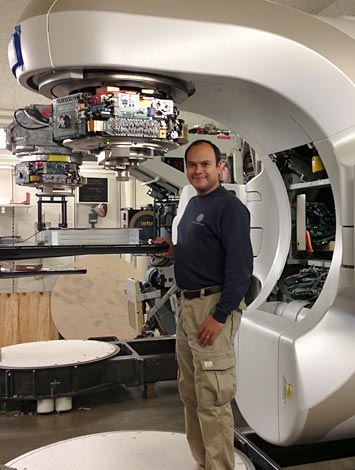RHIC Physics Feeds Future High-Tech Workforce: Anuj Purwar
Anuj Purwar applies knowledge and skills gained as a Ph.D. student at RHIC to R&D on using radiation to treat cancer
December 11, 2012

Anuj Purwar standing next to Varian Medical Systems' flagship "TrueBeam Edge" radiosurgery system
Anuj Purwar, who conducted research as a member of RHIC’s PHENIX collaboration to earn his Ph.D. in experimental nuclear physics from Stony Brook University, now applies the knowledge and skills he gained to further R&D in using radiation to treat cancer. He’s a senior staff physicist at Varian Medical Systems, based in Palo Alto, CA.
“I use my knowledge of radiation detectors, linear accelerators, and nuclear physics that I got from RHIC to come up with innovative solutions to the problem of delivering high doses of ionizing radiation to cancerous tumors while minimizing collateral damage to normal tissues,” he said.
Specifically, he works on compact linear accelerators and gaseous ionizing radiation detectors to improve the steering and focusing of cancer-killing beams and ensure that optimized doses of radiation can be delivered precisely to tumors, as well as the design of radiation shielding.
“Although there are differences—e.g., RHIC is about 2.4 miles around, operates at 200 billion electron volts, and uses superconducting magnets for beam steering, while the Varian linacs are about 1 meter long, top out at 22 million electron volts, and use ordinary electromagnets—my experience at PHENIX with accelerator physics applies directly to what I do every day.”
Purwar’s postdoc work on silicon pixel detectors and data acquisition equipment at Los Alamos National Laboratory—still as a member of RHIC’s PHENIX experiment—also has a direct bearing on his current job, as do the types of computational simulations performed for analyzing nuclear physics experimental data.
“My experience at RHIC prepared me very well for R&D in medical physics.”
2012-3507 | INT/EXT | Newsroom









